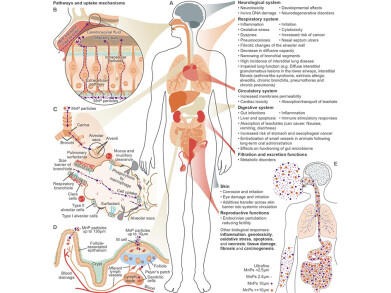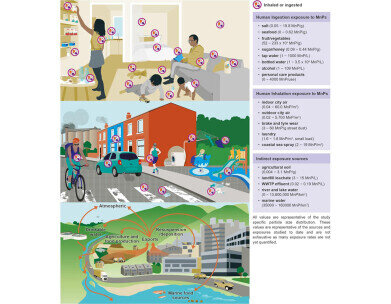-
 Figure 2. Hypothesized uptake mechanisms of MnPs through human body (A–D) (A) Hypothesized uptake mechanisms of MnPs through human biological barriers, including via (B) the olfactory bulb, (C) the lung-air barrier, and (D) the gastrointestinal tract, indicating also the systems and organs directly affected by MnPs and the associated MnP impacts and suspected adverse health out comes including NCDs. The suspected particle-size fractionation caused by differences in the uptake mechanisms (A–D) is highlighted in (E), with larger particles being ingested (up to 130 mm) rather than inhaled (%2.5 mm) and only the smallest (nanoscale) particles being able to penetrate the blood-brain barrier. MnP internalized by routes (C) and (D) reach the wider circulatory system and from there can reach all organs.
Figure 2. Hypothesized uptake mechanisms of MnPs through human body (A–D) (A) Hypothesized uptake mechanisms of MnPs through human biological barriers, including via (B) the olfactory bulb, (C) the lung-air barrier, and (D) the gastrointestinal tract, indicating also the systems and organs directly affected by MnPs and the associated MnP impacts and suspected adverse health out comes including NCDs. The suspected particle-size fractionation caused by differences in the uptake mechanisms (A–D) is highlighted in (E), with larger particles being ingested (up to 130 mm) rather than inhaled (%2.5 mm) and only the smallest (nanoscale) particles being able to penetrate the blood-brain barrier. MnP internalized by routes (C) and (D) reach the wider circulatory system and from there can reach all organs. -
 Figure 1. Environmental exposure routes, transport, and sources of MnPs Environmental exposure routes and sources of MnPs in indoor (top) and outdoor environments (middle). Human exposure rates are determined by the environmental fate and transport of MnPs that control the connectivity between spatially and temporally dynamic environmental pollution sources and human exposures (bottom). Together, these dynamic exposure controls determine the combined uptake of MnPs and their additives that may influence the risk and/or severity of NCDs. The text boxes provide some example exposure ranges associated with different MnP sources.
Figure 1. Environmental exposure routes, transport, and sources of MnPs Environmental exposure routes and sources of MnPs in indoor (top) and outdoor environments (middle). Human exposure rates are determined by the environmental fate and transport of MnPs that control the connectivity between spatially and temporally dynamic environmental pollution sources and human exposures (bottom). Together, these dynamic exposure controls determine the combined uptake of MnPs and their additives that may influence the risk and/or severity of NCDs. The text boxes provide some example exposure ranges associated with different MnP sources.
Air monitoring
Rising micro- and nanoplastic levels linked to increased health risks
Jul 24 2024
A new study reveals that the rising global levels of micro- and nanoplastics (MnPs) absorbed into the human body may heighten the risk of cancer, diabetes, cardiovascular disease, and chronic lung disease. These non-communicable diseases (NCDs) are associated with inflammatory conditions in the body's organs, and the tiny MnP particles can enhance their uptake within the digestive and respiratory systems, potentially increasing the risk and severity of NCDs in the future.
Notably, MnP concentrations in infant faecal matter are significantly higher than in adults. This disparity is likely due to the prevalent use of plastic in infant food preparation, presentation, and storage, as well as young children's tendency to put objects in their mouths.
An international group of researchers published these findings in Cell Reports Medicine and is advocating for a global integrated One Health approach to human health and environmental research. This approach aims to uncover the environmental mechanisms behind the rise in human MnP exposure and their links to NCDs.
Lead author Professor Stefan Krause from the University of Birmingham emphasised the urgency of addressing plastic pollution: "Plastic pollution has increased globally, making it critical to understand the overall health risks associated with MnP exposure. We must tackle this pollution at its source to reduce further emissions, as the global dispersal of MnPs that has already occurred will remain a concern for centuries."
The researchers draw parallels between MnPs and other particles, such as natural pollen and human-made pollutants like diesel exhaust. The body treats these particles as foreign entities, triggering protective mechanisms that can become overwhelmed, thereby increasing the frequency and severity of NCDs.
NCDs are on the rise globally, responsible for 71% of all annual deaths and projected to have an economic impact exceeding $30 trillion over the next two decades. Co-author Semira Manaseki-Holland from the University of Birmingham stressed the importance of understanding the interaction between MnPs and NCDs to advance global prevention and treatment efforts, particularly toward the UN Sustainable Development Goal of reducing premature mortality from NCDs by 2030. This is especially critical in low- and low-middle-income countries, where NCD prevalence is rising alongside high levels of plastic pollution.
Global pollution trends show that MnPs, defined as particles smaller than 5 mm for microplastics and smaller than 1 µm for nanoplastics, are ubiquitous. They have been detected in lungs, blood, breast milk, placenta, and stool samples, confirming that MnPs enter the human body from various environmental sources. Humans are exposed to MnPs through food, drinks, air, cosmetics, and personal care products.
MnPs have been found in fish, salt, beer, bottled drinks, and air, released from synthetic clothing, plastic fabric bedding, plastic carpet, and furniture. Other sources include fertilisers, soil, irrigation, and uptake into food crops. Human exposure to MnPs varies significantly based on location and exposure mechanism, with indoor air pollution hotspots containing up to 50 times more particles than outdoor air.
Co-author Professor Iseult Lynch from the University of Birmingham highlighted the need for a comprehensive understanding of the human health risks associated with MnPs, calling for close collaboration between environmental and medical scientists to achieve this goal.
Digital Edition
AET 29.2 May 2025
May 2025
Water / Wastewater- From Effluent to Excellence: Microbiological assessment of a containerized modular water reuse pilot system- Without water everything comes to a haltAir Monitoring- Probe Sampli...
View all digital editions
Events
Aug 04 2025 Rockville, MD, USA
2025 China International Coal & Mining Exhibition
Aug 07 2025 Beijing, China
Aug 13 2025 Jakarta, Indonesia
Aug 24 2025 Stockholm, Sweden and online
Aug 26 2025 Lima, Peru












.jpg)







